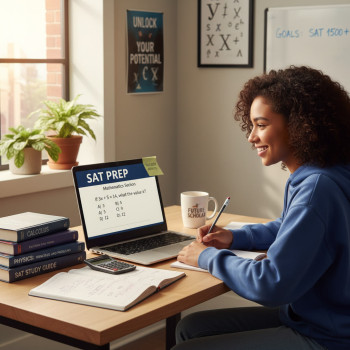Why Music for Studying? The Short, Honest Answer
It’s tempting to think music is just background noise — but the right kind of sound can be a study ally. For many students preparing for the Digital SAT, the challenge isn’t only mastering algebra or evidence-based reading; it’s building sustained focus, resisting scrolling temptations, and making practice sessions feel purposeful. Focus music apps are tools that help shape the environment where learning happens. Used well, they can quiet internal chatter, normalize consistent study blocks, and even cue your brain that it’s time to work.
What ‘Focus Music’ Actually Means
When we say “focus music,” we don’t mean pop songs with catchy hooks. We mean audio designed to support concentration: ambient textures, low-tempo electronic loops, instrumental piano, binaural beats, and curated playlists that minimize surprise. These sounds reduce abrupt attention shifts and help you slip into a flow state — the mental zone where time collapses and problem-solving gets easier.
How Focus Music Apps Fit into SAT Preparation
Preparing for the Digital SAT is an interplay of knowledge, strategy, and stamina. Focus music apps are not a replacement for smart study plans or expert feedback, but they are a practical hack to make study sessions more productive. Think of music apps as the room’s lighting: when it’s right, everything else works better.
Three practical roles music can play during prep
- Transition cue: Start the same playlist or sound to mark the beginning of a focused session.
- Attention scaffold: Use steady, unobtrusive audio to lower the chance your brain jumps to distractions.
- Recovery tool: Gentle music can help you unwind between intense practice blocks, preventing burnout.
Choosing the Right Type of Music for Different Study Tasks
Not every study activity benefits from the same sound. Your verbal reasoning practice, math drills, and full-length practice tests each have different cognitive demands. Below are practical recommendations you can try and tweak to fit your style.
What to play when you’re doing Reading & Writing practice
Reading comprehension and sentence structure questions require careful, linear thinking. You want music that supports calm, deep attention without pulling language-processing resources away from the task.
- Best choices: instrumental piano, soft ambient pads, minimal classical (e.g., slow strings).
- Volume: low to moderate — loud enough to mask background noise, quiet enough not to compete with inner speech.
- Avoid: vocal music in your native language, dramatic crescendos, or anything with unpredictable changes.
What to play for Math and Data Analysis practice
Math often benefits from a sharper focus and rhythm: steady beats can help maintain momentum on problem sets, especially when you’re practicing pacing for the Digital SAT’s question types.
- Best choices: lo-fi hip hop without vocals, downtempo electronic, or binaural-beat tracks tuned for concentration (if you respond well to them).
- Use rhythmic tracks for timed drills; switch to calmer textures for deep-concept study.
What to play during full-length practice tests
Full-length practice tests measure stamina and mimic the test environment. Since the actual Digital SAT is silent (proctored), music is a training tool to build endurance and pacing — not a crutch you’ll have during the real test day.
- Best approach: simulate quiet conditions for one section, then try light ambient during breaks to practice recovery.
- If you prefer music during long sessions, use consistent, unobtrusive playlists so your focus doesn’t depend on novelty.
Practical Ways to Integrate Focus Music Apps into Your Study Routine
Here’s a simple, adaptable framework you can apply whether you study for 30 minutes or four hours. Try it for a week and notice how your attention, energy, and mood change.
Step-by-step routine (easy to customize)
- Plan: Decide the subject and objective for your session (e.g., “30 minutes—algebra practice, target: mastering slope-intercept problems”).
- Set a playlist: Pick one playlist or track that becomes your cue for that task type.
- Timebox: Use the Pomodoro technique (25–30 minute focused blocks + 5–10 minute breaks) or adapt to longer 50–10 blocks for deeper problems.
- Reset: Between blocks, switch to a recovery track or silence; stand up, stretch, hydrate, and write one quick note about progress.
Example Weekly Schedule with Focus Music
Below is a sample weekly study schedule that shows how different music styles align with tasks. Tailor the frequency and duration to your deadlines and energy patterns.
| Day | Session (mins) | Task | Music Style | Goal |
|---|---|---|---|---|
| Monday | 60 (2 x 25 + breaks) | Reading passages | Soft piano/ambient | Speed + accuracy on 2 passages |
| Wednesday | 90 (3 x 25) | Algebra problem set | Lo-fi instrumental | Master linear systems |
| Friday | 120 (practice test section) | Math + Calculator section | Ambient / low beat for drills; silence for timed sections | Simulate real test pace |
| Sunday | 45 | Essay planning / note review | Minimal classical | Organize strategies and notes |
How to Use App Features Strategically
Most focus music apps are more than playlists. Explore features and match them to your study goals.
Useful app features and how to use them
- Timer integration: Sync a playlist to your Pomodoro or custom timer so music starts and stops with your blocks.
- Crossfade and loop settings: Choose seamless loops to avoid sudden audio changes that break concentration.
- Mood or task presets: Save playlists labeled by task (e.g., “Reading Focus,” “Math Drills”).
- Offline downloads: Download playlists so network hiccups won’t interrupt a timed session.
- Volume normalization: Enable this to prevent loud advertisements or sudden spikes.
Measuring What Works: Simple Metrics to Track
Not every playlist helps every student. Keep this lightweight tracking system to discover what truly improves your sessions.
Three quick metrics
- Completion rate: What percentage of scheduled blocks do you finish? If it drops, change the music or the block length.
- Accuracy: Track error rates on practice questions when using different playlists.
- Subjective focus score: Rate each session 1–5 for perceived focus and energy.
Sample Tracking Table You Can Copy
| Date | Task | Music | Block Type | Completion (%) | Focus Score (1–5) | Notes |
|---|---|---|---|---|---|---|
| 2025-09-01 | Reading | Soft piano | 25 mins | 100 | 4 | Good pacing; fewer rereads |
| 2025-09-02 | Algebra drills | Lo-fi beats | 50 mins | 80 | 3 | Got distracted toward end; lower volume next time |
Common Pitfalls and How to Fix Them
It’s easy to make small mistakes that undermine the benefits of focus music. Here’s how to troubleshoot when music isn’t helping.
When music becomes a distraction
- Problem: You notice yourself focusing on lyrics or song changes. Fix: Switch to instrumental or ambient tracks — novelty is the enemy of sustained focus.
- Problem: Volume spikes or ads interrupt study. Fix: Use subscription features or offline mode to ensure uninterrupted playback.
- Problem: You rely on a specific track to start studying and can’t focus without it. Fix: Gradually vary your cue sounds so focus becomes internalized, not external.
How Sparkl’s Personalized Tutoring Can Amplify Your Music-Backed Routine
Music is a fantastic support, but targeted guidance accelerates progress. That’s where tailored tutoring comes in. For example, Sparkl’s personalized tutoring complements your music-driven routines by offering 1-on-1 guidance and tailored study plans. An expert tutor can:
- Help you choose the right tasks to pair with your playlists (so music supports learning, not masks weaknesses).
- Design a study plan that balances content review, strategy work, and timed practice — all aligned to the moments music enhances most.
- Use AI-driven insights to track which study patterns correlate with gains and refine your approach week by week.
That combination — consistent focus routines plus targeted feedback — turns isolated practice into measurable improvement.
Personalizing Your Sound: Quick Experiments to Find Your Best Setup
Your brain is the final judge. Run short A/B tests to identify what helps your scores, not what sounds cool.
Three mini-experiments (30 minutes each)
- Experiment A: Ambient/no rhythm during reading passages. Compare time per question and comprehension to a silent control.
- Experiment B: Lo-fi beats for math drills vs. silence. Measure accuracy and time-to-completion on similar problem sets.
- Experiment C: Binaural-beat tracks for focus vs. instrumental music. Track subjective focus and any physiological response (restlessness, calm).
Real-World Tips from Students Who Use Music to Study
Here are practical habits that students report help them get the most from focus music apps.
- Build a “study playlist” and resist changing it during a session. Familiarity reduces novelty and helps attention.
- Use instrumental music for reading-heavy tasks and rhythmic low-tempo music for calculation-based drills.
- Pair music with a visible timer. The combo of auditory cue and clear countdown boosts accountability.
- Keep a short physical notebook for “distraction notes” — jot down a stray thought during a session so you can return to it later without breaking focus.
Putting It All Together: A 4-Week Music-Augmented Study Plan
Below is a compact plan to integrate focus music apps into your prep across a month. It balances skill-building, timed practice, and reflection.
Week 1 — Find Your Sounds
- Goal: Test three music styles (ambient, lo-fi, minimal classical) across different tasks.
- Action: 5 short sessions per style; track focus and completion.
Week 2 — Build Routine and Timing
- Goal: Establish a reliable session structure (e.g., 2 Pomodoros per day).
- Action: Use a consistent playlist per task type; introduce practice tests with silence for sections to simulate test conditions.
Week 3 — Intensify Practice
- Goal: Increase session difficulty (harder problem sets, stricter timing).
- Action: Use rhythmic tracks for drills and ambient tracks for review; meet weekly with a tutor or mentor for feedback.
Week 4 — Simulate Test Stamina and Review
- Goal: Take at least one full-length practice test under near-test conditions.
- Action: Use silence for actual test sections to practice endurance; use music during breaks to recover efficiently.
Final Advice: Keep It Flexible and Student-Centered
What works for one student may not work for another. The point of using focus music apps is to create conditions where high-quality study is repeatable. Use the guidance above, measure your outcomes, and adjust. If you find certain tracks boost your accuracy or help you sustain longer sessions, double down on them. If not, iterate. Over time, you’ll learn the subtle signals your brain gives when it’s genuinely focused versus when it’s merely occupied.
When to seek targeted help
If you’re consistently studying and not seeing score improvement, it might be time for more personalized intervention. Sparkl’s one-on-one tutors can diagnose content gaps, design tailored study plans, and use AI-driven insights to ensure your practice — with or without music — leads to real gains. Combining disciplined routines with expert feedback is one of the fastest ways to improve.
Closing Encouragement
Music won’t magically raise your SAT score, but used strategically it smooths the path to better study. Think of focus music apps as a study partner that helps your best work show up more often. Pair them with thoughtful practice, honest tracking, and occasional tutoring feedback, and you’ll be building both skills and the stamina to shine on test day. Start small, track one or two metrics, and celebrate the tiny wins — they add up faster than you think.
Good luck, and happy studying — may your playlists be steady and your focus unshakeable.













No Comments
Leave a comment Cancel